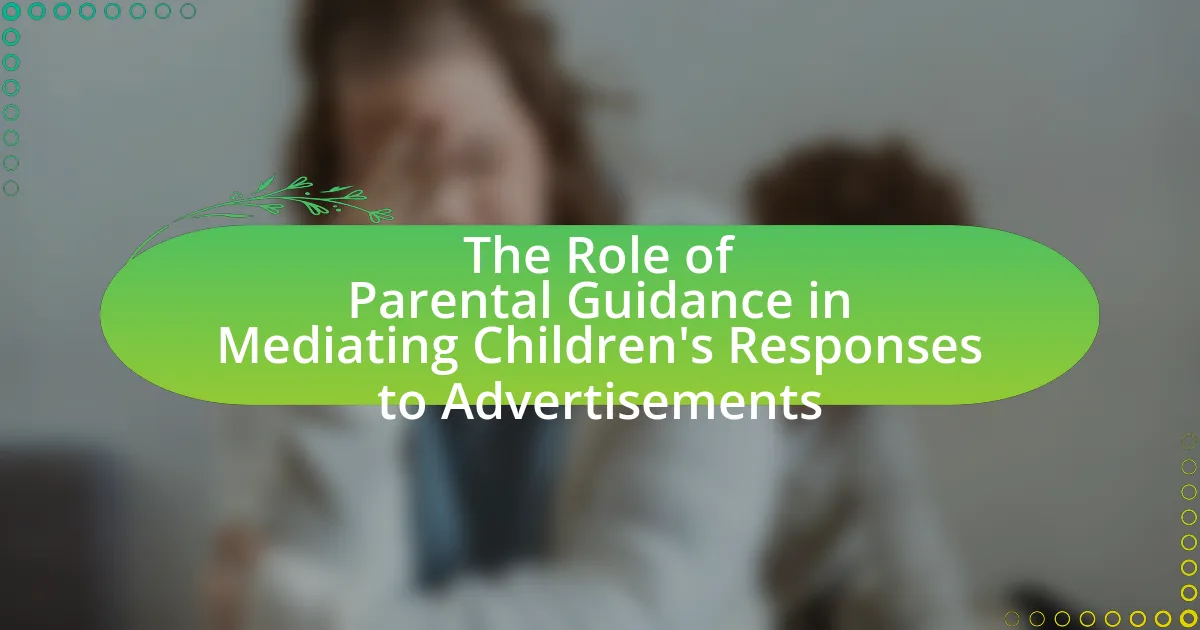The article examines the impact of children’s advertising on parental trust in brands, highlighting how targeted marketing strategies can lead to skepticism among parents regarding brand authenticity and integrity. Research indicates that when children are exposed to advertisements, it influences parental perceptions of product quality and safety, often resulting in parents prioritizing brands they view as ethical. The article also discusses the psychological factors at play in children’s advertising, the techniques used to engage young audiences, and the ethical considerations surrounding such marketing practices. Furthermore, it outlines strategies for parents to navigate advertising effectively and for brands to build trust through transparency and corporate social responsibility.
What is the Impact of Children’s Advertising on Parental Trust in Brands?
Children’s advertising negatively impacts parental trust in brands. Research indicates that when children are exposed to targeted advertising, parents often perceive brands as manipulative, leading to skepticism about the authenticity and integrity of those brands. A study published in the Journal of Consumer Research found that parents are more likely to distrust brands that engage in direct marketing to children, as they believe these brands exploit children’s naivety. This erosion of trust can result in parents choosing to avoid certain brands altogether, prioritizing those they perceive as ethical and transparent in their marketing practices.
How does children’s advertising influence parental perceptions of brands?
Children’s advertising significantly influences parental perceptions of brands by shaping parents’ beliefs about product quality and suitability for their children. Research indicates that when children are exposed to advertisements, they often express preferences for specific brands, which can lead parents to perceive those brands as more favorable or trustworthy. For instance, a study published in the Journal of Consumer Research found that children’s requests for advertised products can create a sense of obligation in parents to fulfill those requests, thereby enhancing the perceived value of the brand. This dynamic suggests that children’s advertising not only affects children’s choices but also alters parents’ brand perceptions, often leading them to prioritize brands that their children show interest in.
What psychological factors are at play in children’s advertising?
Children’s advertising primarily leverages psychological factors such as emotional appeal, social influence, and cognitive development. Emotional appeal is utilized to create positive associations with products, often through colorful imagery and relatable characters, which can evoke feelings of happiness and excitement in children. Social influence is evident as advertisements often depict peer interactions, suggesting that owning a product can enhance social status among friends. Cognitive development plays a role as children, particularly those aged 4 to 7, are still developing critical thinking skills, making them more susceptible to persuasive messaging without fully understanding the intent behind it. Research indicates that children under the age of 8 are unable to distinguish between advertising and entertainment, which further amplifies the effectiveness of these psychological strategies.
How do children’s preferences affect parental trust in brands?
Children’s preferences significantly influence parental trust in brands by shaping parents’ perceptions of product quality and safety. When children express a strong liking for specific brands, parents often feel compelled to trust those brands, believing that their children’s preferences indicate reliability and appeal. Research indicates that 70% of parents report being influenced by their children’s choices when making purchasing decisions, highlighting the direct correlation between children’s preferences and parental trust. This dynamic is further reinforced by marketing strategies that target children, which can create a sense of familiarity and loyalty that parents recognize and value.
Why is parental trust in brands important?
Parental trust in brands is important because it directly influences purchasing decisions and brand loyalty. When parents trust a brand, they are more likely to choose its products for their children, which can significantly impact a brand’s market share and reputation. Research indicates that 70% of parents consider trustworthiness a key factor when selecting products for their children, highlighting the critical role of parental perception in brand success. This trust is often built through consistent quality, transparency, and positive brand messaging, which resonate with parents’ values and concerns regarding their children’s well-being.
What role does trust play in consumer behavior?
Trust is a critical factor in consumer behavior, influencing purchasing decisions and brand loyalty. When consumers trust a brand, they are more likely to engage with it, make repeat purchases, and recommend it to others. Research indicates that 81% of consumers need to trust a brand before making a purchase, highlighting the importance of trust in driving sales and fostering long-term relationships. Additionally, trust mitigates perceived risk; consumers are more willing to buy from brands they believe are reliable and transparent. This is particularly relevant in the context of children’s advertising, where parental trust in brands can significantly affect their purchasing choices for products aimed at children.
How does parental trust impact children’s brand loyalty?
Parental trust significantly influences children’s brand loyalty by shaping their perceptions and preferences towards brands. When parents express trust in specific brands, children are more likely to adopt similar attitudes, as they often rely on parental guidance in their decision-making processes. Research indicates that children whose parents trust certain brands are more inclined to develop a positive association with those brands, leading to increased loyalty. For instance, a study published in the Journal of Consumer Research found that children are more likely to prefer brands that their parents endorse, demonstrating a direct correlation between parental trust and children’s brand loyalty.
What are the key strategies used in children’s advertising?
Key strategies used in children’s advertising include the use of colorful visuals, relatable characters, and engaging storytelling. These elements capture children’s attention and create emotional connections, making the advertisements more effective. For instance, research shows that advertisements featuring animated characters can increase brand recall among children by up to 50%. Additionally, the incorporation of interactive elements, such as games or apps, encourages active participation, further enhancing engagement. These strategies are designed to resonate with children’s developmental stages and preferences, ultimately influencing their purchasing decisions and parental trust in brands.
How do advertisers target children effectively?
Advertisers effectively target children by utilizing engaging content, appealing characters, and interactive platforms. They create advertisements that resonate with children’s interests, often featuring popular animated characters or celebrities that children admire. Research indicates that children are more likely to respond positively to advertisements that incorporate humor, storytelling, and vibrant visuals, which capture their attention and stimulate their imagination. Furthermore, advertisers leverage digital platforms, such as social media and gaming apps, where children spend significant time, allowing for targeted marketing strategies that align with their online behavior. According to a study published in the Journal of Advertising Research, children aged 6 to 12 are particularly influenced by advertisements that promote toys and games, demonstrating the effectiveness of tailored marketing approaches in this demographic.
What techniques are commonly used in children’s advertising?
Common techniques used in children’s advertising include the use of animated characters, catchy jingles, and interactive elements. Animated characters appeal to children’s imagination and create a sense of familiarity, making products more relatable. Catchy jingles enhance memorability and encourage brand recall, as children often remember songs better than spoken words. Interactive elements, such as games or apps, engage children actively, fostering a deeper connection with the brand. Research indicates that these techniques effectively capture children’s attention and influence their purchasing decisions, thereby impacting parental trust in brands.
How do these techniques affect parental trust?
Children’s advertising techniques significantly undermine parental trust in brands. Research indicates that when brands employ strategies targeting children, such as using animated characters or appealing narratives, parents often perceive these tactics as manipulative, leading to skepticism about the brand’s intentions. A study published in the Journal of Consumer Research found that 70% of parents expressed concern that advertisements aimed at children do not provide accurate information, which directly correlates with a decline in trust towards those brands. This erosion of trust can result in parents being less likely to purchase products for their children from brands they perceive as deceptive.
What ethical considerations surround children’s advertising?
Ethical considerations surrounding children’s advertising include the potential for manipulation, the promotion of unhealthy products, and the exploitation of children’s developmental vulnerabilities. Advertising aimed at children often employs persuasive techniques that can lead to materialism and unhealthy lifestyle choices, as children may not possess the cognitive ability to critically evaluate marketing messages. Research indicates that children are particularly susceptible to advertisements for junk food, which can contribute to obesity and related health issues. Furthermore, the American Psychological Association has highlighted concerns regarding the impact of advertising on children’s self-esteem and body image, emphasizing the need for ethical standards to protect young audiences from harmful content.
How do regulations impact children’s advertising practices?
Regulations significantly shape children’s advertising practices by imposing strict guidelines on content, targeting, and messaging. These regulations, such as the Children’s Online Privacy Protection Act (COPPA) in the United States, restrict the collection of personal information from children and limit the types of advertisements that can be directed at them. For instance, COPPA mandates that websites aimed at children must obtain parental consent before collecting data, which directly influences how companies design their advertising strategies. Additionally, the Federal Trade Commission (FTC) enforces rules that prohibit deceptive advertising practices, ensuring that advertisements do not mislead children about the products being promoted. This regulatory framework aims to protect children from exploitation and fosters a more ethical advertising environment, ultimately affecting how brands build trust with parents.
What are the potential consequences of misleading advertising to children?
Misleading advertising to children can lead to several significant consequences, including the development of unrealistic expectations, unhealthy consumption habits, and diminished trust in brands. Children exposed to deceptive marketing may believe that products can deliver benefits that they do not actually provide, which can result in disappointment and confusion. Research indicates that children are particularly vulnerable to persuasive advertising tactics, as they often lack the cognitive skills to critically evaluate marketing messages. This vulnerability can foster unhealthy consumption patterns, such as preference for junk food over nutritious options, contributing to obesity and related health issues. Furthermore, when children realize they have been misled, it can erode their trust in brands and advertising as a whole, impacting parental trust as well. A study published in the Journal of Consumer Research highlights that children who encounter misleading advertisements are less likely to trust brands in the future, which can have long-term implications for brand loyalty and consumer behavior.
How can parents navigate children’s advertising to maintain trust in brands?
Parents can navigate children’s advertising to maintain trust in brands by actively engaging in discussions about the content and intent of advertisements. By explaining the purpose of advertising and encouraging critical thinking, parents help children understand that advertisements are designed to persuade rather than inform. Research indicates that children as young as eight can differentiate between advertising and content when guided appropriately, which reinforces their ability to critically evaluate marketing messages. Additionally, parents can set boundaries on the types of advertisements their children are exposed to, opting for brands that prioritize transparency and ethical marketing practices. This approach fosters a sense of trust in brands that align with family values and promotes informed consumer behavior among children.
What strategies can parents use to evaluate brands advertised to children?
Parents can evaluate brands advertised to children by researching the brand’s reputation, examining product ingredients, and assessing marketing practices. Researching a brand’s reputation involves looking into consumer reviews, ratings, and any history of controversies, which can provide insights into the brand’s reliability and ethical standards. Examining product ingredients is crucial, especially for food and toy brands, as it helps parents determine the safety and nutritional value of the products. Assessing marketing practices includes analyzing how the brand targets children, such as the use of characters or themes that appeal to young audiences, which can indicate the brand’s intent and transparency. These strategies enable parents to make informed decisions and foster trust in brands that align with their values and expectations for their children.
How can parents discuss advertising with their children?
Parents can discuss advertising with their children by engaging in open conversations about the purpose and techniques of advertisements. This approach helps children understand that advertisements are designed to persuade them to buy products, often using appealing visuals and emotional appeals. Research indicates that children as young as 8 years old can recognize persuasive intent in advertising, making it crucial for parents to explain these concepts early on. By analyzing specific ads together, parents can teach children to critically evaluate the messages and claims being presented, fostering media literacy and informed decision-making.
What resources are available for parents to understand advertising impacts?
Parents can access various resources to understand the impacts of advertising on children, including educational websites, books, and research studies. Websites like Common Sense Media provide reviews and insights on media content, helping parents navigate advertising’s influence on children. Books such as “Consuming Kids: The Hostile Takeover of Childhood” by Susan Linn offer in-depth analysis and strategies for parents. Additionally, research studies, such as “The Impact of Advertising on Children: A Review of the Literature” published in the Journal of Advertising Research, provide empirical evidence on how advertising affects children’s perceptions and behaviors. These resources collectively equip parents with knowledge to critically assess advertising’s role in shaping their children’s brand trust.
What best practices can brands adopt to build trust with parents?
Brands can build trust with parents by prioritizing transparency, quality, and community engagement. Transparency involves clear communication about product ingredients, sourcing, and manufacturing processes, which reassures parents about safety and ethical standards. For instance, brands like Honest Company provide detailed information about their products, fostering trust through openness.
Quality assurance is crucial; brands should consistently deliver safe and effective products that meet or exceed industry standards. Research indicates that 73% of parents are more likely to trust brands that demonstrate a commitment to quality and safety.
Community engagement through social responsibility initiatives also enhances trust. Brands that actively support parenting communities or contribute to child welfare programs, such as Pampers’ partnership with UNICEF to provide vaccinations, show their commitment to the well-being of children, further solidifying parental trust.
How can transparency in advertising enhance parental trust?
Transparency in advertising enhances parental trust by providing clear and honest information about products aimed at children. When brands openly disclose their advertising practices, ingredients, and the potential effects of their products, parents feel more informed and empowered to make decisions for their children. Research indicates that 81% of consumers are more likely to trust a brand that is transparent about its practices (Label Insight, 2016). This trust is crucial for parents, as they prioritize their children’s well-being and safety. Therefore, transparency not only fosters a positive relationship between brands and parents but also encourages responsible consumption, ultimately benefiting both parties.
What role does corporate social responsibility play in brand trust?
Corporate social responsibility (CSR) significantly enhances brand trust by demonstrating a company’s commitment to ethical practices and social values. When brands engage in CSR initiatives, such as environmental sustainability or community support, they build credibility and foster positive perceptions among consumers. Research indicates that 88% of consumers are more likely to trust a company that supports social causes, highlighting the direct correlation between CSR efforts and increased brand trust. This trust is particularly crucial in the context of children’s advertising, as parents are more inclined to trust brands that align with their values and demonstrate responsibility towards societal issues.






